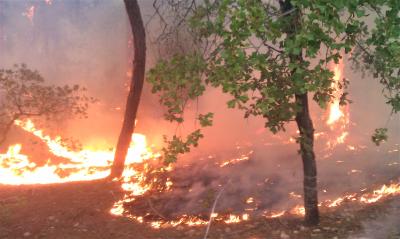
Defensible Space
Two factors have emerged as the primary determinants of a home's ability to survive wildfire. These are the home's roofing material and the quality of the "defensible space" surrounding it. Use fire-resistive materials, not wood or shake shingles, to roof homes in or near forests and grasslands. When your roof needs significant repairs or replacement, do so with a fire-resistive material.
Defensible space is an area around a structure where fuels and vegetation are treated, cleared or reduced to slow the spread of wildfire towards the structure. It also reduces the chance of a structure fire moving from the building to the surrounding forest or grasslands. Defensible space provides room for firefighters to do their jobs. Your house is more likely to withstand a wildfire if grasses, brush, trees and other common forest fuels are managed to reduce a fire's intensity.
The actual design and development of your defensible space depends on several factors: size and shape of buildings, materials used in their construction, the slope of the ground on which the structures are built, surrounding topography, and sizes and types of vegetation on your property.
Look at creating 3 different management zones for your defensible space.
- Zone 1-is the area of maximum modification and treatment. It consists of an area of 15 feet around the structure in which all flammable vegetation is removed.
- Zone 2- is an area of fuel reduction. It is a transitional area between Zones 1 and 3. The size of Zone 2 depends on the slope of the ground where the structure is built. Typically, the defensible space should extend at least 75 to 125 feet from the structure.
- Zone 3- is an area of traditional forest management and is of no particular size. It extends from the edge of your defensible space to your property boundaries.
ZONE 1
Plant nothing within 3-5 feet of the structure, particularly if the building is sided with wood, logs or other flammable materials. Decorative rock, for example creates an attractive, easily maintained, nonflammable ground cover. If the house has noncombustible siding, widely spaced foundation plantings of low growing shrubs or other "firewise" plants are acceptable. Do not plant directly below windows or next to foundation vents. Be sure there are no areas of continuous grass adjacent to plantings in this area. Prune and maintain plants in this zone to ensure vigorous growth and a low growth habit. Remove dead branches, stems and leaves. Do not store firewood or other combustible materials in this area. Do not use areas under decks for storage. Ideally, remove all trees from this zone to reduce fire hazards. If you do keep a tree try to isolate the tree from other surrounding trees. Prune it to at least 10 feet above the ground. Remove any branches that interfere with the roof or are within 10 feet of the chimney. Remove all "ladder fuels" from beneath the tree. Ladder fuels are vegetation with vertical continuity that allows fire to burn from ground level up into the branches and crowns of trees. No ladder fuels can be allowed under tree canopies.
ZONE 2
This area of fuel reduction is designed to reduce the intensity of any fire approaching your home. Thin trees and large shrubs so there is at least 10 feet between crowns. On steep slopes, allow more space between tree crowns. Remove all ladder fuels from under these remaining trees. Isolated shrubs may remain, provided they are not under tree crowns. Prune and maintain these plants periodically removing dead stems from trees and shrubs annually. Mow grasses as needed through the growing season to keep them low, a maximum of 6-8 inches. This is extremely critical in the late summer and fall when grasses dry out and cure. Stack firewood and woodpiles uphill or on the same elevation as the structure but at least 30 feet away. Keep flammable vegetation at least 10 feet away from these woodpiles. Dispose of slash (limbs, branches and other woody debris) from your trees and shrubs through chipping or by pilling and burning.
ZONE 3
A gradual transition into this zone from defensible space standards to other management objectives you may have is suggested. Pruning and mowing is generally not necessary in this zone but can add to the aesthetics of the area.
Even small steps to protect your home and property will make them more able to withstand fire. If you need more information on creating wildfire-defensible zones or living in the wildland-urban interface contact your local fire department.


